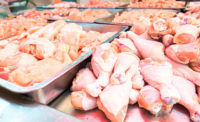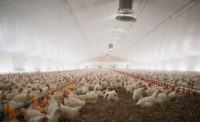Special Report | State of the Industry 2020
The state of the chicken industry 2020: easing toward a new normal

When a look ahead was taken a year ago at this time, the discussion focused on the pending game-changer. That is, when and how much will the China market reopen for U.S. chicken? Anticipation was high with companies willing, ready and able to supply China with more than enough chicken feet, leg quarters and more. U.S. chicken exports to China have been one bright spot for broiler companies in 2020.
But another, more impactful game-changer came crashing into the picture as the New Year unfolded. As the first quarter of 2020 came to an end, it was painfully obvious that the world had dramatically changed — and not for the better.
State of the Industry 2020
OverviewBeef (NCBA)
Beef (FQF)
Pork
Chicken
Turkey
Veal
Lamb
Seafood
Food Safety
Workforce
Sustainability
Packaging
Watch the 2020 State of the Industry Webinar
Register for free today!
The situation is a good reminder of what baseball legend Casey Stengel said of never making predictions, especially about the future.
COVID-19 tossed the broiler industry into new waters, and the industry responded.
In response to the pandemic, chicken companies added additional protective measures to help keep our essential employees safe and healthy. Companies are following Centers for Disease Control and Prevention (CDC) and local health department guidelines. Measures include social distancing; temperature checks; installing plastic barriers between work stations where social distancing is challenging; providing masks, face shields and gloves for workers; staggering shifts; making break rooms available outside; multiple hand-sanitizing stations; extra cleaning and sanitation of the plant; educating employees in multiple languages about steps to take at home to keep healthy; encouraging sick or vulnerable employees to stay home with paid sick leave; and testing for the virus.
The health and safety of the essential employees working to keep chicken on our tables has been, and continues to be the industry’s No. 1 priority.
In the marketplace, COVID-19 has resulted in unprecedented challenges and changes to both chicken supply and demand.
Although the U.S. chicken industry has addressed the disruptions to operations somewhat better than competing meats, the burden being carried is nonetheless unprecedented. Volatility, especially in the foodservice and export markets, is continuing to increase uncertainty in decision-making about future production and product plans.
While breast tenders and wings are enjoying a ride in their own orbit, the back-of-the-bird will likely continue to face challenges until overseas sales find a stronger upward path. Also, with average bird weights during the first half of 2020 up 2.5 percent over a year earlier, the abundance of breast and thigh meat for deboning has provided consumers with excellent values.
ANNUAL BROILER FORECASTS
| 2016 | 2017 | 2018 | 2019 | 2020 | 2021 | |
| Production (million lb.) | 40,696 | 41,662 | 42,601 | 43,905 | 44,552 | 45,020 |
| Per capita disappearance (retail lb.)* | 89.8 | 91.1 | 92.6 | 95.1 | 96.4 | 97.1 |
| Broiler exports (million lb.) | 6645 | 6786 | 7069 | 7103 | 7186 | 7140 |
Forecasts are in bold. * Per capita meat and egg disappearance data are calculated using the Resident Population Plus Armed Forces Overseas series from the Census Bureau of the Department of Commerce. All data as of Sept 17, 2020. Source: World Agricultural Supply and Demand Estimates and Supporting Materials. For further information, contact: Mildred M. Haley, mhaley@ers.usda.gov
With consumers preparing significantly more food at home, they have increased their purchases of chicken from grocery stores by double digits. Fresh, frozen and prepared chicken products have benefited. Home cooks are seeking new recipes and preparation ideas to provide family meals with variety and interest. Chicken — with its convenience and versatility — is a natural fit in this regard.
Foodservice is beginning to return to a level experienced before the pandemic; however, it will not be surprising to see in the future that many home cooks will continue to enjoy a stepped-up level of preparing and serving homemade meals and snacks. Chicken will continue to be a main ingredient in that mix.
FROZEN/REFRIG. CHICKEN/CHICKEN SUBSTITUTE:
TOP 10 RETAIL BRANDS
| Brand | Dollar Sales | Dollar Sales % Chg YAgo | Unit Sales | Unit Sales % Chg YAgo |
| Private Label | $1,134,090,675 | 18.0% | 138,647,116 | 11.4% |
| Tyson | $344,485,424 | -9.6% | 41,628,900 | -8.3% |
| Perdue | $150,682,247 | 30.7% | 28,944,305 | 12.5% |
| Kraft Heinz TGI Friday's | $122,601,093 | 14.9% | 25,994,404 | 11.4% |
| Just Bare | $113,437,366 | 38.2% | 15,895,141 | 37.0% |
| Barber Foods | $103,355,398 | 26.3% | 14,504,623 | 16.0% |
| Perdue Harvestland | $90,064,613 | 14.1% | 13,973,371 | 8.9% |
| Perdue Perfect Portions | $89,213,694 | 12.6% | 10,686,873 | 1.5% |
| Pilgrim's | $56,552,462 | 45.7% | 5,551,334 | 44.1% |
| Gold Leaf | $54,134,034 | 25.2% | 9,454,678 | 26.4% |
| Total Frozen/Refrig. Chicken/Chicken Substitute | $2,966,906,963 | 18.2% | 432,132,496 | 12.7% |
| Total Frozen/Refrig. Poultry | $4,750,722,997 | 17.8% | 765,275,208 | 12.2% |
Source: IRI, a Chicago-based market research firm (@iriworldwide). Total US - Multi Outlet w/ C-Store (Grocery, Drug, Mass Market, Convenience, Military and Select Club & Dollar Retailers), latest 52 weeks ending Sept. 6, 2020. Note: Rankings of top brands are NOT totaled brands (e.g. all brand lines/extensions rolled up into a single figure), but rather individual brand lines.
The U.S. Department of Agriculture (USDA) is calling for a chicken production increase for this year to be somewhat less than 2 percent and an even more modest step-up of less than 1.5 percent for 2021. At the same time, department analysts argue that lower feed costs during 2020-21 will motivate an increase in chicken production. Traditionally, this correlation between feed costs and pounds produced has been a relatively good argument. But given the experience of the ongoing pandemic, caution is much more likely as the year end comes into closer sight and 2021 begins to signal its opportunities and challenges.
REFRIGERATED BREAKFAST SAUSAGE/HAM:
Top 5 Retail Brands
| Brand | Dollar Sales | Dollar Sales % Chg YAgo | Unit Sales | Unit Sales % Chg YAgo |
| Tyson | $1,156,483,023 | 27.7% | 165,700,620 | 24.5% |
| Private Label | $619,384,730 | 33.1% | 100,930,779 | 30.6% |
| Tyson Any'tizers | $360,865,931 | 25.4% | 49,908,313 | 21.8% |
| Perdue | $233,823,964 | 24.7% | 45,814,232 | 11.0% |
| Tyson Grilled & Ready | $169,171,733 | 16.0% | 24,341,161 | 14.3% |
| Foster Farms | $154,495,263 | 24.1% | 24,449,044 | 23.1% |
| John Soules Foods | $136,313,005 | 17.9% | 32,854,754 | 16.2% |
| Banquet | $104,251,482 | 9.2% | 19,378,560 | 5.3% |
| Perdue Short Cuts | $99,197,510 | 6.6% | 24,911,791 | -0.3% |
| Perdue Simply Smart Organics | $89,273,678 | 50.9% | 11,432,041 | 26.7% |
| Total Processed Frz./Refrig. Chicken/Chicken Substitute | $3,793,465,243 | 24.8% | 608,786,943 | 19.0% |
| Total Processed Frozen/Refrig. Poultry | $3,868,733,866 | 24.5% | 621,666,159 | 18.6% |
Source: IRI, a Chicago-based market research firm (@iriworldwide). Total US - Multi Outlet w/ C-Store (Grocery, Drug, Mass Market, Convenience, Military and Select Club & Dollar Retailers), latest 52 weeks ending Sept. 6, 2020. Note: Rankings of top brands are NOT totaled brands (e.g. all brand lines/extensions rolled up into a single figure), but rather individual brand lines.
If USDA’s outlook proves correct regarding production and exports, average per-capita chicken consumption in 2020 will be more than 98 pounds and almost 99 pounds in 2021. Is 100 pounds not that far off?
There is general agreement in the industry and elsewhere that the COVID-19 pandemic will continue but will gradually begin to ease as consumers, the economy and society return to a more normal rhythm of life. There is, however, much less consensus regarding the pace and timetable for a defined recovery. A reading of industry reports regarding this question indicates some optimism for first quarter next year and a bit more hopefulness for this achievement by mid-2021.
Whenever the eventual resolution arrives, there is total agreement that it didn’t come soon enough to see it in the rear-view mirror. NP
Looking for a reprint of this article?
From high-res PDFs to custom plaques, order your copy today!









